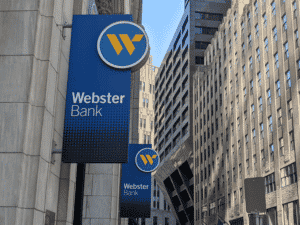While merger expenses led to a quarterly loss for Webster Bank’s parent company, bank executives say they have already seen the combination with Sterling National Bank reflected in financial performance.
Stamford, Connecticut-based Webster Financial Corp., the holding company for Webster Bank and its HSA Bank division, had a first-quarter net loss of $20.2 million, or a loss of $0.14 per diluted share, compared to net income of $106.1 million, or $1.17 per diluted share, in the first quarter of 2021.
Webster closed on the Sterling acquisition on Jan. 31, and first-quarter results included expenses totaling $279.5 million pre-tax, or $204.3 million after-tax, that primarily represented merger-related expenses as well as an initial non-purchase credit deteriorated provision, the bank said in its first-quarter earnings statement.
Excluding these expenses, first-quarter earnings per diluted share would have been $1.24, the bank said.
“This was a landmark quarter for Webster, as we closed our merger of equals with Sterling Bancorp,” John R. Ciulla, Webster’s president and CEO, said in the statement. “We are excited about our future as a combined entity, as we are adding scale, talent, and capabilities that will enhance our client experience. I am equally proud we were able to produce strong underlying business trends while at the same time combining these complementary organizations.”
Webster in the first quarter also completed the acquisition of Bend Financial Inc., which the bank said would “advance our delivery of a differentiated modern approach to HSA management and engagement.”
Reflecting the Sterling acquisition, Webster had total assets at the end of the first quarter of $65.1 billion, nearly doubling the $33.26 billion in assets from the first quarter of 2021.
The deposit balance at the end of the first quarter was $54.4 billion. Webster in the first quarter of 2021 had $28.5 billion in deposits.
The bank’s loan and lease balance was $43.5 billion at the end of the first quarter compared to $21.3 billion in the first quarter of 2021. The bank had 80 percent of its balance in commercial loans and 20 percent in consumer loans.
Compared to Dec. 31, when loans totaled $22.3 billion, Webster’s commercial loans increased by $8.8 billion, commercial real estate loans increased by $11 billion, residential mortgages increased by $1.4 billion and consumer loans increased by $88.3 million, the bank said.
“The power of our combined entity is already evident in our financial performance,” Glenn MacInnes, Webster’s executive vice president and chief financial officer, said in the statement. “On an adjusted basis, we generated a return on assets of 1.37 percent and return on tangible common equity of 17 percent. We also exhibited meaningful growth in key product categories, and anticipate carrying this momentum into future periods.”









